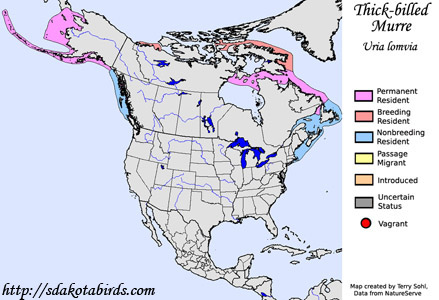| Length: 18 inches | Wingspan: 28 inches | Seasonality: Non-resident in South Dakota |
| ID Keys: Dark upperparts, light underparts, thicker shorter bill and stockier neck than Common Murre | ||
 The
Thick-billed Murre is a large Auk found along both the Atlantic and Pacific
Coasts of North America. They are cold-water birds, breeding in
northern Canada and Alaska, and only found near the lower 48 states during
the winter months. They are very similar to the
Common Murre, and are often found
nesting in the same locations. They can be distinguished from Common
Murres by their stockier appearance, thicker neck, and shorter and stouter
bill.
The
Thick-billed Murre is a large Auk found along both the Atlantic and Pacific
Coasts of North America. They are cold-water birds, breeding in
northern Canada and Alaska, and only found near the lower 48 states during
the winter months. They are very similar to the
Common Murre, and are often found
nesting in the same locations. They can be distinguished from Common
Murres by their stockier appearance, thicker neck, and shorter and stouter
bill.
Habitat: Found on rocky islands or shorelines, using areas with steep rocky cliffs and ledges for nest sites. Outside of breeding, they are found in cold waters, often very far from shore.
Diet: Feeds mostly on fish, but will also eat crustaceans, squid, and marine worms.
Behavior: Forages by diving and swimming underwater after prey. They can dive to depths of up to 200 feet.
Nesting: The Thick-billed Murre doesn't build a nest. The female lays a single egg directly on the ground, usually on a rocky ledge of a cliff face. Both the male and female help to incubate the egg, and both parents help to feed and raise the nestling after it hatches.
Song: On breeding grounds, has a groaning, startling aaarrrrrrrr call. Usually silent away from breeding colonies.
Migration: Birds can be found as far north as open water exists during the winter, although some birds do move southward. There is more movement southward for the winter in Atlantic populations than in Pacific populations.
Interactive eBird map: Click here to access an interactive map of Thick-billed Murre sightings
Similar Species: Common Murre, Razorbill
Conservation Status: Populations of Thick-billed Murre are widespread, they are common in many areas, and populations appear to be stable overall, or possibly increasing. The IUCN lists the Thick-billed Murre as a species of "Least Concern".
Further Information: 1) Alaska Seabird Information Series - Thick-billed Murre
2) Audubon Guide - Thick-billed Murre
3) BirdWeb - Thick-billed Murre
Photo Information: Photo taken by Alastair Rae - June 5th, 2006 - Photo licensed under Creative Commons Attribution ShareAlike 2.0 Generic License
| Click below for a higher-resolution map |
 |
| South Dakota Status: Non-resident in South Dakota |
Additional Thick-billed Murre Photos (coming soon!!)
